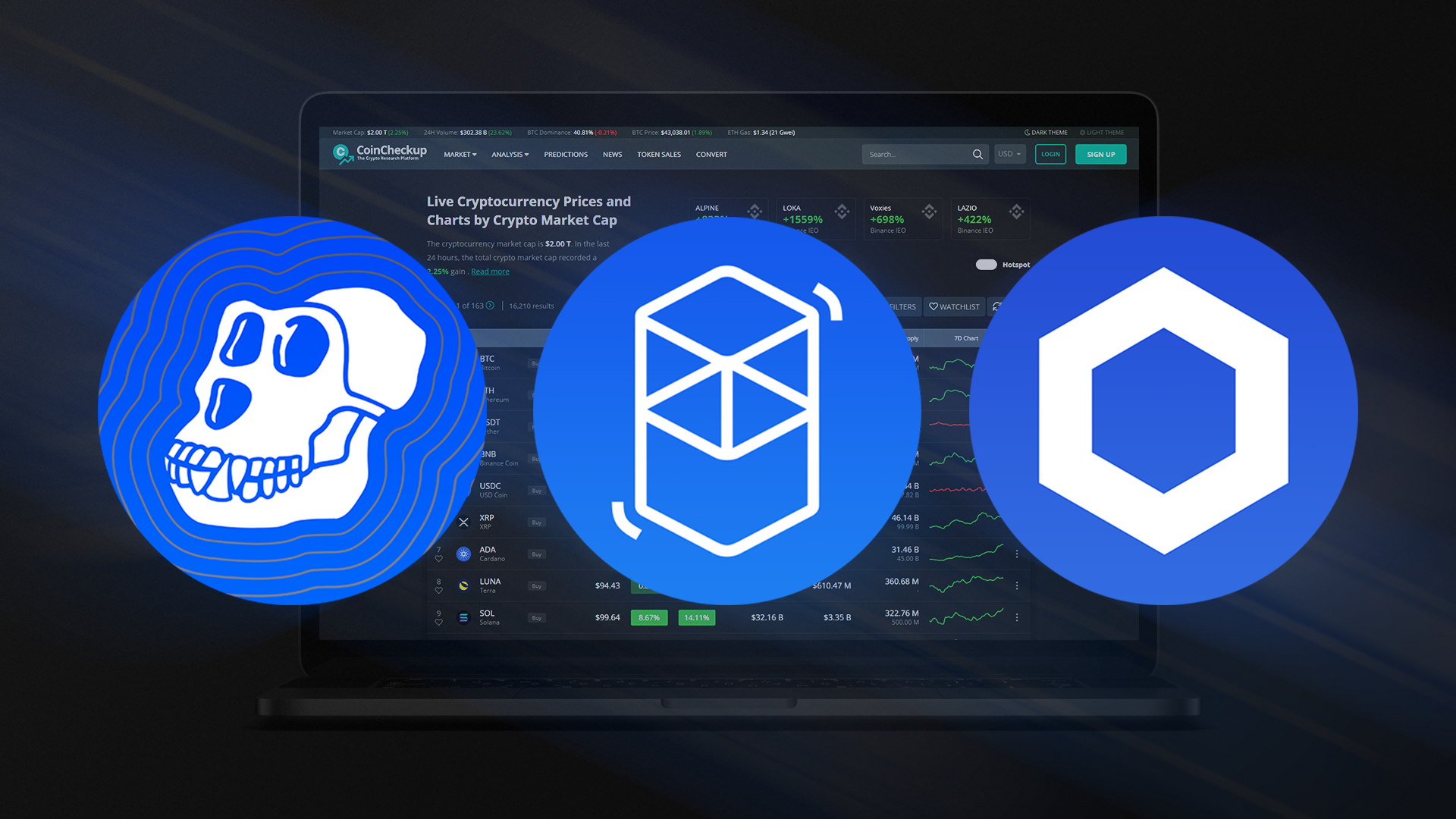
The cryptocurrency sector’s total market capitalization has climbed from $858 billion to $874 billion last week, which marks already the second week of recovery after the FTX fiasco. Interestingly, there were no big movers among Top 100 Crypto, with the vast majority of coins staying between the -10%/+10% price change interval. Find out what we think in this week’s Top 3 Coins to Watch article. Are you hoping for bigger moves in the upcoming week or are you completely fine with a slow-paced recovery?

3. ApeCoin (APE)
ApeCoin is an ERC-20 token launched by the ApeCoin DAO in March 2022. Besides being a decentralized currency that facilitates monetary transactions, APE has a few additional use cases, including granting its holders governance rights in the ApeCoin DAO and providing access to exclusive events and services. The total supply of APE stands at 1 billion tokens, out of which 150 million tokens were distributed to holders of the NFTs from the popular Bored Ape Yacht Club (BAYC) and Mutant Ape Yacht Club (MAYC) collections.
ApeCoin staking is scheduled to go live on December 7
ApeCoin project managers have took it to Twitter to announce that a much-anticipated feature – ApeCoin staking – will soon be deployed. Staking is a common process among crypto process that lets token owners earn rewards by locking up and holding their assets using a specialized smart contract.
The APE staking, which will be powered by a Horizen Labs-developed smart contract is set to hit the mainnet on December 7 if no critical bugs are found in the code. However, the rewards will only start to accrue 5 days later, this is on December 12. While most APE holders had no problem with such schedule, the fact that staking feature will be geo-blocked raised a significant amount of dust. What is more, staking will be made inaccessible to residents of the United States and Canada, which are home to an estimated 50% of the ApeCoin community members. ApeCoin developers, who are aware of the magnitude of this inconvenience, cited regulatory limitations as the reason for the geo-blocking. Leaving the soon-to-be-deployed APE staking aside, the ApeCoin DAO recently launched a community-led NFT marketplace. The marketplace developed by Snag Solutions offers “unique features built specifically for the BAYC and Otherside communities, including ApeCoin staking and NFT metadata integrations” as well as halved fees (only 0.25%) for transactions conducted with ApeCoin.

2. Fantom (FTM)
Fantom is a fast, high-throughput open-source smart contract platform for digital assets and dApps. It is a Layer 1 network competing with the likes of Avalanche, Solana, and Terra to dethrone Ethereum. Fantom utilizes Asynchronous Byzantine Fault Tolerance (aBFT) consensus algorithm. The aBFT algorithm promises to debunk the blockchain Scalability Trilemma, according to which only two of the crucial three components that include decentralization, security, and scalability, are achievable at the same time. FTM was one of the best-performing assets of 2021, in which it appreciated by approximately 13,000%.
Fantom to implement a “gas monetization” program to reward top Fantom dApps
Investors have been rather bullish on FTM last week as the Fantom’s coin leads all top 100 crypto assets in terms of weekly gains with +25%. Likely the reason is the proposal of a dApp Gas monetization program, through which the Fantom Foundation seeks to reward high-quality dApps and retain talented creators within the ecosystem.
f the proposal is passed by the FTM DAO, the Foundation would pay a portion of the network fees of the high-performing dApps that manage to generate a steady traffic. The FTM developers explained that only DApps with 1,000,000 or more recorded transactions and at least three months of operation on the Fantom Opera network will be able to apply for a 15% gas fee repayment. However, it should be noted that the Fantom Foundation would have to slash the protocol’s current FTM token burn-rate from 20% to 5% to fund this program. In addition, one of the earliest Fantom developers and a prominent crypto advocate Andre Cronje has recently returned to the Fantom project, of which we wrote about four weeks ago. Do you think Cronje has more improvement ideas up his sleeve?

1. Chainlink (LINK)
Chainlink is a decentralized oracle network that provides data and price oracles, which act as a reliable feed of off-chain information for some smart contracts. The project launched in 2017, when it also raised $32 million of funding through an ICO. Chainlink’s cryptocurrency price and real-world data oracles have seen numerous implementations and their popularity is still increasing. Their oracle service is one of the most reliable and trustworthy services available and the connection with smart contracts is end-to-end secured, leaving very little space for the manipulation of the execution of smart contracts. Another Chainlink feature is Verifiable Random Function (VRF), which proved to be very useful as providing a source of verifiable randomness in blockchain gaming and when minting NFTs.
Chainlink is launching LINK staking on December 6
On #1 spot of our this week’s Top 3 Coins to Watch list is another project that is preparing to roll-out a coin staking feature – Chainlink. LINK staking, which is the core part of the so-called “Chainlink Economics 2.0” upgrade, is set to go live on Ethereum mainnet on December 6, 2022, at 12:00 PM ET. The launch of staking will enable LINK token holders and node operators to earn rewards while helping increase the cryptoeconomic security of oracle services at the same time.
At first only the addresses that qualify for Early Access will have the opportunity to stake up to 7,000 LINK. LINK staking will be made available to all Chainlink holders two days later, while still retaining the 7,000 LINK per address hard cap. The whole roadmap and more details of the LINK staking deployment can be found here. LINK currently trades at the price of $7.40 per token and is up by only 4.2% last week. Although the token is up by almost 30% from the local low of $5.72 reached on November 21, several analysts believe that the launch of the “Chainlink Economics 2.0” has not been fully priced in yet. Furthermore, technical analysis also shows a possibility of a rally, which will move the price up by a further 25%. According to the historical prices LINK could climb toward $9.40 by the second week of December, provided it breaks out of the ascending triangle pattern. In addition, also the prominent market analyst and founder of Eight Global, Michaël van de Poppe, sees LINK crossing $9 in the near future.



